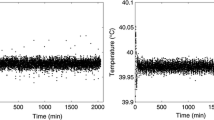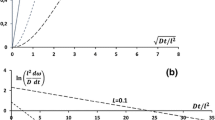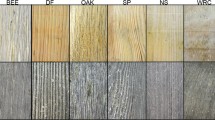Summary
Round wood wafers, 4 mm thick along the grain and 2 cm in cross-sectional diameter, of green basswood (Tilia americana L.), yellow birch (Betula alleghaniensis Britton), and black cherry (Prunus serotina Ehrh.), and initially dried to equilibrium in air of 77% relative humidity and 25°C, were exposed to sinusoidally varying relative humidity between 77 and 47% at 25°C for many cycles at each of four different cycling periods, 5.33, 10.67, 16.0 and 25.33 hours. Moisture changes and radial and tangential dimensional changes in response to the imposed humidities, measured during initial drying and subsequent cycling, gave the following results:
-
1.
The moisture and dimensional changes were generally sinusoidal but lagged behind the imposed humidity. The phase lag decreased and the amplitude increased with increasing cycling period. Both responses and phase lags approached repetitive or “steady-state” values as cycling was prolonged.
-
2.
A numerical solution for moisture diffusion, assuming a constant diffusion coefficient and sinusoidally varying boundary moisture conditions, was used to simulate the average moisture content in the wafer at any time. The resulting curves were qualitatively similar to those obtained experimentally, the differences attributed primarily to the effects of hysteresis and stress relaxation.
-
3.
The mean moisture diffusion coefficients, calculated from steady-state phase lag data combined with an analytical solution of the diffusion equation, decreased with increasing cycling period. The values obtained increased with decreasing wood specific gravity as anticipated, but their magnitudes were somewhat lower than theoretical values.
-
4.
The dynamic moisture expansion coefficient was relatively constant during successive cycles, with no consistent effect of cycling period. The dynamic values were generally higher than the static values.
-
5.
The dynamic humidity expansion coefficient increased with increasing cycling period. It was only about half that obtained from static experiments, presumably because of hysteresis.
-
6.
The dynamic moisture sorption coefficient, which is the effective slope of the dynamic sorption isotherm, decreased with increasing number of cycles and decreasing cycling period. It was less than half the calculated static sorption isotherm in the same humidity range, presumably due to hysteresis.
Similar content being viewed by others
References
Armstrong, L. D.; Kingston, R. S. T. 1962: The effect of moisture content changes on the deformation of wood under stress. Aust. J. Appl. Sci. 13:257–276
Bolton, A. J.; Jardine, P.; Vine, M. H.; Walker, J. F. 1974: The swelling of wood under mechanical restraint. Holzforschung 28:138–144
Bryan, E. L.; Schniewind, A. P. 1965: Strength and rheological properties of particle boards as affected by moisture content and sorption. Forest. Prod. J. 15: 143–148
Carslaw, H. S.; Jaeger, J. C. 1959. Conduction of heat in solids. 2nd ed. London: Oxford Univ. Press
Chomcharn, A. 1975: Transverse hygroexpansion of wood wafers under sinusoidally varying relative humidity. Ph.D. Thesis. SUNY Coll. Envir. Sci. and For., Syracuse, N.Y.
Chomcharn, A.; Skaar, C. 1983: Moisture and transverse dimensional changes during airdrying of small green hardwood wafers. Wood Sci. Technol. 17:227–240
Christensen, G. N.; Kelsey, K. E. 1959. The rate of sorption of water vapor by wood. Holz Roh-Werkst. 17: 178–188
Crank, J. 1956: The mathematics of diffusion. London: Oxford University Press
Handbook of Hardwoods. 1956, 1972: The handbook of hardwoods. 1st and 2nd eds. London: her Majesty Stationary Office
Harris, J. M. 1961: The dimensional stability, shrinkage intersection point and related properties of New Zealand timbers. Tech. Paper No. 36, N.Z., For. Res. Inst., Wellington
Narayanamurti, D.; Verma, G. M. 1972. Swelling and shrinkage of wood under mechanical restraint: Influence of various factors on Tectona grandis. Holzforsch. Holzverwert. 24:83–93
Panshin, A. J.; de Zeeuw, C. 1980: Textbook of Wood Technology, 4th ed. New York: McGraw-Hill
Perkitny, T. 1960: Pressure variation in differently pre-pressed and rigidly clamped wood specimens. Holz Roh- Werkst. 18:200–210
Schniewind, A. P. 1967: Creep-rupture life of D-fir under cyclic environmental conditions. Wood Sci. Technol. 1:278–288
Schniewind, A. P.; Lyon, E. D. 1973: Further experiment of creep-rupture life under cyclic environmental conditions. Wood Fiber 4: 334–341
Siau, J. F. 1971: Flow in wood. Syracuse: Syracuse Univ. Press
Simpson, W. T. 1974: Measuring dependence of diffusion coefficient of wood on moisture concentration by adsorption experiments. Wood Fiber 5:299–307
Skaar, C. 1972: Water in wood, Syracuse: Syracuse Univ. Press
Spalt, H. A. 1957: The sorption of water vapor by domestic and tropical woods. Forest. Prod. J. 7: 331–335
Stevens, W. C. 1963: The transverse shrinkage of wood. Forest. Prod. J. 8: 386–389
Takahashi, A.; Schniewind, A. P. 1974: [Deformation and drying set during cyclic drying and wetting under tensile loads.] J. Jpn. Wood Res. Soc. 20:9–14
Tokumoto, J. 1973: [Moisture recovery of drying set. I: Swelling behaviors of set wood. II: Effect of quantity of adsorbed moisture and dry-wet cyclings on set recovery in wood.] J. Jpn. Wood Res. Soc. 19:577–584, and 585–591
Wilkinson, T. L. 1966: Moisture cycling of trussed rafter joints. U.S. For. Serv. Res. Pap. FPL-67. Madison, Wisconsin
Wood Handbook 1974: Wood as an engineering material. Agriculture Handbook No. 72. Washington, D.C.: U.S. Government Printing Office
Author information
Authors and Affiliations
Additional information
This paper is based on a PhD. dissertation of the senior author in the Wood Products Engineering Department of the SUNY College of Environmental Science and Forestry, Syracuse, NY 13210, USA. The author are indebted to Dr. C. H. de Zeeuw for his contribution to the dissertation as co-advisor
Rights and permissions
About this article
Cite this article
Chomcharn, A., Skaar, C. Dynamic sorption and hygroexpansion of wood wafers exposed to sinusoidally varying humidity. Wood Sci.Technol. 17, 259–277 (1983). https://doi.org/10.1007/BF00349914
Received:
Issue Date:
DOI: https://doi.org/10.1007/BF00349914




